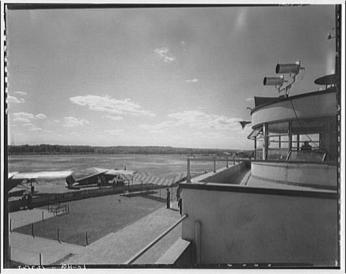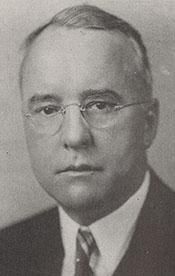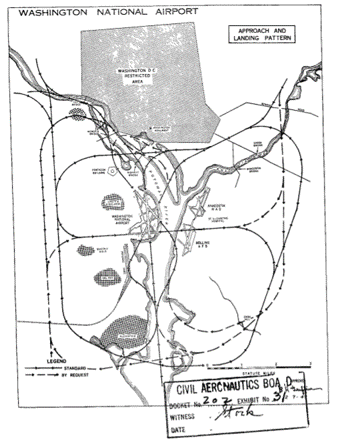Welcome to DU!
The truly grassroots left-of-center political community where regular people, not algorithms, drive the discussions and set the standards.
Join the community:
Create a free account
Support DU (and get rid of ads!):
Become a Star Member
Latest Breaking News
Editorials & Other Articles
General Discussion
The DU Lounge
All Forums
Issue Forums
Culture Forums
Alliance Forums
Region Forums
Support Forums
Help & Search
American History
Related: About this forumOn this day, November 1, 1949, a P-38 collided with an Eastern Air Lines DC-4 at Washington National Airport.
My mom used to talk about this.
The link to the map doesn't work. DU's software tries to turn the character string "& p a r a m s" into "¶ m s". I can't think of a workaround.
Eastern Air Lines Flight 537
Date: November 1, 1949
Summary: Mid-air collision
Site: Alexandria, Virginia, United States
38°50.1'N 77°02.7'W
Total fatalities: 55
Total injuries: 1
Total survivors: 1
First aircraft

An Eastern Air Lines Douglas DC-4, similar to the one involved in the crash
Type: Douglas DC-4
Operator: Eastern Air Lines
Registration: N88727
Flight origin: LaGuardia Airport, Queens, New York
Destination: Washington-National Airport, DC
Occupants: 55
Passengers: 51
Crew: 4
Fatalities: 55
Survivors: 0
Second aircraft

A Lockheed P-38J Lightning, the type involved in the crash
Type: Lockheed P-38L Lightning
Operator: Lockheed
Registration: NX-26927
Occupants: 1
Crew: 1
Fatalities: 0
Injuries: 1
Survivors: 1
Eastern Air Lines Flight 537, registration N88727, was a Douglas DC-4 aircraft en route from Boston, Massachusetts to Washington, D.C. via intermediate points on November 1, 1949. NX-26927 was a Lockheed P-38 Lightning being test-flown for acceptance by the Government of Bolivia by Erick Rios Bridoux of the Bolivian Air Force. The two aircraft collided in mid-air at an altitude of 300 feet about half a mile southwest of the threshold of Runway 3 at Washington National Airport, killing all 55 aboard the DC-4 and seriously injuring the pilot of the P-38. At the time it was the deadliest airliner incident in United States history.
The tower controllers on duty that day at National testified that the P-38 had taken off on Runway 3, turned left north of The Pentagon, circled over Arlington, then returned, requesting permission to land due to engine trouble. The controller cleared the aircraft to join the left traffic pattern, but instead it flew south of the airport and entered a long straight-in approach at the same time Flight 537 was turning onto a shorter final. The controller then called Flight 537 ordering it to turn left; it began the turn, but by then the P-38, being considerably faster than a DC-4 on final, overtook the aircraft 1/2 mile southwest of the threshold of Runway 3.
The DC-4 was cut in half by the left propeller of the P-38 just forward of the trailing edge of the wing. The aft portion of the DC-4 fell to the ground on the west bank of the Potomac River; other pieces were located in Alexandria, Virginia at the Richmond, Fredericksburg & Potomac Railroad Potomac Yard and on a highway passing near the Yard. The fore portion of the aircraft fell into the river, as did the P-38.
{snip}
Date: November 1, 1949
Summary: Mid-air collision
Site: Alexandria, Virginia, United States
38°50.1'N 77°02.7'W
Total fatalities: 55
Total injuries: 1
Total survivors: 1
First aircraft

An Eastern Air Lines Douglas DC-4, similar to the one involved in the crash
Type: Douglas DC-4
Operator: Eastern Air Lines
Registration: N88727
Flight origin: LaGuardia Airport, Queens, New York
Destination: Washington-National Airport, DC
Occupants: 55
Passengers: 51
Crew: 4
Fatalities: 55
Survivors: 0
Second aircraft

A Lockheed P-38J Lightning, the type involved in the crash
Type: Lockheed P-38L Lightning
Operator: Lockheed
Registration: NX-26927
Occupants: 1
Crew: 1
Fatalities: 0
Injuries: 1
Survivors: 1
Eastern Air Lines Flight 537, registration N88727, was a Douglas DC-4 aircraft en route from Boston, Massachusetts to Washington, D.C. via intermediate points on November 1, 1949. NX-26927 was a Lockheed P-38 Lightning being test-flown for acceptance by the Government of Bolivia by Erick Rios Bridoux of the Bolivian Air Force. The two aircraft collided in mid-air at an altitude of 300 feet about half a mile southwest of the threshold of Runway 3 at Washington National Airport, killing all 55 aboard the DC-4 and seriously injuring the pilot of the P-38. At the time it was the deadliest airliner incident in United States history.
The tower controllers on duty that day at National testified that the P-38 had taken off on Runway 3, turned left north of The Pentagon, circled over Arlington, then returned, requesting permission to land due to engine trouble. The controller cleared the aircraft to join the left traffic pattern, but instead it flew south of the airport and entered a long straight-in approach at the same time Flight 537 was turning onto a shorter final. The controller then called Flight 537 ordering it to turn left; it began the turn, but by then the P-38, being considerably faster than a DC-4 on final, overtook the aircraft 1/2 mile southwest of the threshold of Runway 3.
The DC-4 was cut in half by the left propeller of the P-38 just forward of the trailing edge of the wing. The aft portion of the DC-4 fell to the ground on the west bank of the Potomac River; other pieces were located in Alexandria, Virginia at the Richmond, Fredericksburg & Potomac Railroad Potomac Yard and on a highway passing near the Yard. The fore portion of the aircraft fell into the river, as did the P-38.
{snip}
Boundary Stones: WETA's Washington DC History Blog
Death Over the Potomac
8/17/2021 in DC by Ben Miller

View of National Airport's control tower, from which traffic controllers watched Flight 537 crash in 1949. [Source: Library of Congress.]
Ralph and Mildred Miller just wanted to get home. After an autumn trip to Europe in 1949, the Chevy Chase couple had dealt with 24-hours of delays as bad weather blocked their return to Maryland. But skies were clear on the morning of November 1. The Millers boarded Eastern Airlines Flight 537 from New York and flew south uneventfully. But as they prepared to land at National Airport, their DC-4 airliner suddenly lurched left. The husband and wife felt a tremendous crash. Then they felt nothing at all.
Over the next three days, the bodies of Ralph, Mildred, and 53 other people were recovered from the frosty waters of the Potomac River. Morgues in D.C. and Alexandria struggled to process their soaked and mutilated remains. In the 40-year history of American aviation, no airplane crash had ever claimed so many lives.
The immediate cause of the crash was no mystery. From their perch at National Airport, air traffic controllers had watched with horror as a P-38 fighter plane, surplus from World War II, descended on Flight 537 and crashed square into its fuselage. The controllers had yelled desperate orders for the P-38 to turn, but it never did. Investigators needed to know why.
There was little out of the ordinary about Flight 537, but the plane it struck was hardly a fixture of the D.C. skies. Piloting the P-38 was Captain Erick Rios Bridoux, Bolivia’s director of civil aviation. Only 29, Rios spoke perfect English and was already considered his country’s best aviator. He came north to inspect the P-38, which Bolivia planned to purchase, and take it on a test flight. On November 1, he looped casually around Northern Virginia before preparing to land at National. The tower told him to circle once, wait for another plan to land, and then do the same. Everything that followed became a subject of debate and litigation.
From the ground, motorists on the George Washington Parkway (then called the Mount Vernon Memorial Highway) heard a massive explosion above them. Within seconds, debris began landing all over the road and the Potomac. J. Donald Mayor jammed on his brakes. To him, it looked like pieces of paper were fluttering from the sky, but they were really shards of metal. He immediately pulled over and ran to the shoreline, where a 50-foot section of the plane was jammed into the mud. Six twisted legs stuck out from the ground. “There was no noise, no groans, or shouts,” he told reporters.
PEPCO workers on a lunch break got an even clearer and gorier view. Glancing up at the sky, C.W. Simpson saw Flight 537 go down, looking like “an acetylene torch had just cut the big plane right in half.” He and his co-workers ran into the water to look for survivors. Most of the bodies they encountered were already dead, but a few clung briefly to life, moaning in pain.
{snip}

Congressmen George Bates had served in the House of Representatives for 12 years when he was killed in the crash. [Source: House of Representatives.]
No one on the DC-4 survived more than a few hours. Their remains were brought to the Alexandria Armory, which the night before had hosted a joyous Halloween party for the city’s youngsters. Now coroners struggled to identify bodies.[5] Because of how expensive early air travel was, the victims were mostly notable and wealthy individuals. Chief among them was Rep. George Bates of Massachusetts, the ranking member on the House District Committee and a major advocate for Washington. He was returning to the Capital after a weekend with his family. Other casualties included Michael Kennedy, the former leader of New York’s Tammany Hall political machine, and beloved New Yorker cartoonist Helen Hokinson.
{snip}

This map depicting both planes' flight patterns was included in the CAB report on the crash. [Source: Department of Transportation.]
{Snip the rest, including many, many links to news accounts in the Evening Star.}
Death Over the Potomac
8/17/2021 in DC by Ben Miller

View of National Airport's control tower, from which traffic controllers watched Flight 537 crash in 1949. [Source: Library of Congress.]
Ralph and Mildred Miller just wanted to get home. After an autumn trip to Europe in 1949, the Chevy Chase couple had dealt with 24-hours of delays as bad weather blocked their return to Maryland. But skies were clear on the morning of November 1. The Millers boarded Eastern Airlines Flight 537 from New York and flew south uneventfully. But as they prepared to land at National Airport, their DC-4 airliner suddenly lurched left. The husband and wife felt a tremendous crash. Then they felt nothing at all.
Over the next three days, the bodies of Ralph, Mildred, and 53 other people were recovered from the frosty waters of the Potomac River. Morgues in D.C. and Alexandria struggled to process their soaked and mutilated remains. In the 40-year history of American aviation, no airplane crash had ever claimed so many lives.
The immediate cause of the crash was no mystery. From their perch at National Airport, air traffic controllers had watched with horror as a P-38 fighter plane, surplus from World War II, descended on Flight 537 and crashed square into its fuselage. The controllers had yelled desperate orders for the P-38 to turn, but it never did. Investigators needed to know why.
There was little out of the ordinary about Flight 537, but the plane it struck was hardly a fixture of the D.C. skies. Piloting the P-38 was Captain Erick Rios Bridoux, Bolivia’s director of civil aviation. Only 29, Rios spoke perfect English and was already considered his country’s best aviator. He came north to inspect the P-38, which Bolivia planned to purchase, and take it on a test flight. On November 1, he looped casually around Northern Virginia before preparing to land at National. The tower told him to circle once, wait for another plan to land, and then do the same. Everything that followed became a subject of debate and litigation.
From the ground, motorists on the George Washington Parkway (then called the Mount Vernon Memorial Highway) heard a massive explosion above them. Within seconds, debris began landing all over the road and the Potomac. J. Donald Mayor jammed on his brakes. To him, it looked like pieces of paper were fluttering from the sky, but they were really shards of metal. He immediately pulled over and ran to the shoreline, where a 50-foot section of the plane was jammed into the mud. Six twisted legs stuck out from the ground. “There was no noise, no groans, or shouts,” he told reporters.
PEPCO workers on a lunch break got an even clearer and gorier view. Glancing up at the sky, C.W. Simpson saw Flight 537 go down, looking like “an acetylene torch had just cut the big plane right in half.” He and his co-workers ran into the water to look for survivors. Most of the bodies they encountered were already dead, but a few clung briefly to life, moaning in pain.
{snip}

Congressmen George Bates had served in the House of Representatives for 12 years when he was killed in the crash. [Source: House of Representatives.]
No one on the DC-4 survived more than a few hours. Their remains were brought to the Alexandria Armory, which the night before had hosted a joyous Halloween party for the city’s youngsters. Now coroners struggled to identify bodies.[5] Because of how expensive early air travel was, the victims were mostly notable and wealthy individuals. Chief among them was Rep. George Bates of Massachusetts, the ranking member on the House District Committee and a major advocate for Washington. He was returning to the Capital after a weekend with his family. Other casualties included Michael Kennedy, the former leader of New York’s Tammany Hall political machine, and beloved New Yorker cartoonist Helen Hokinson.
{snip}

This map depicting both planes' flight patterns was included in the CAB report on the crash. [Source: Department of Transportation.]
{Snip the rest, including many, many links to news accounts in the Evening Star.}
Tue Nov 1, 2022: On this day, November 1, 1949, a P-38 collided with an Eastern Air Lines DC-4 at National Airport.
Mon Nov 1, 2021: On this day, November 1, 1949, a P-38 collided with an Eastern Air Lines DC-4 at National Airport.
Tue Nov 1, 2022: Death Over the Potomac
Mon Nov 1, 2021: Death Over the Potomac
InfoView thread info, including edit history
TrashPut this thread in your Trash Can (My DU » Trash Can)
BookmarkAdd this thread to your Bookmarks (My DU » Bookmarks)
0 replies, 504 views
ShareGet links to this post and/or share on social media
AlertAlert this post for a rule violation
PowersThere are no powers you can use on this post
EditCannot edit other people's posts
ReplyReply to this post
EditCannot edit other people's posts
Rec (3)
ReplyReply to this post